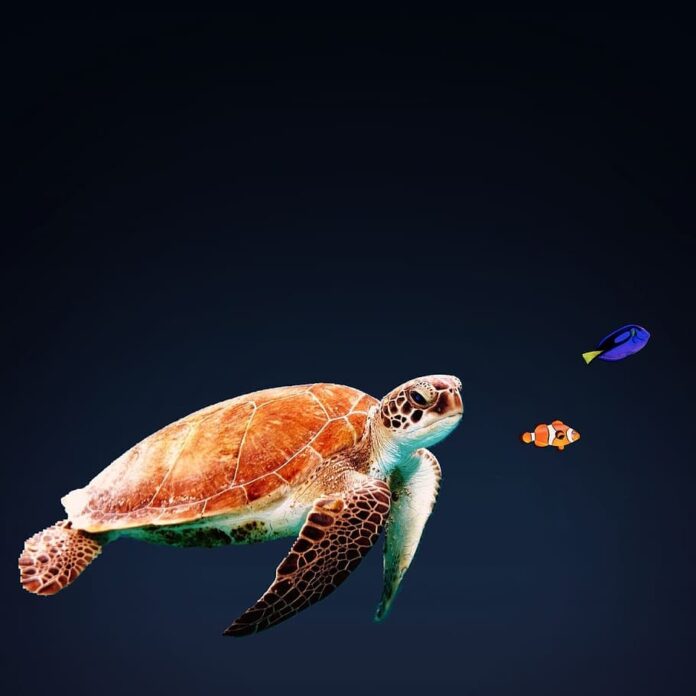Currently, there are 7 marine turtle species that live in every ocean around the world. The concerning factor about our sea turtle species is that they are either endangered or threatened. People can do so much better to save them instead of harming the population of these gentle creatures. Below are the 7 marine turtle species along with some basic details about them.
1Flatback
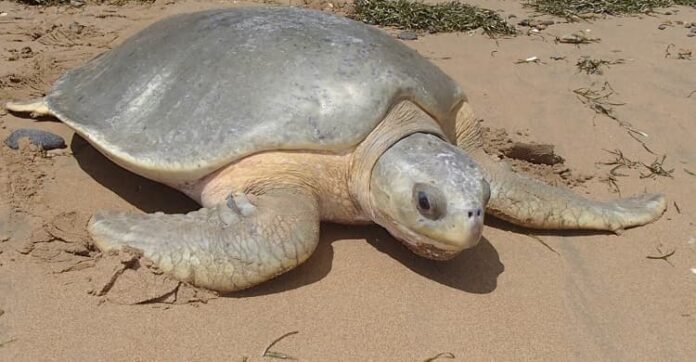
The flatter dome on the shell has earned this sea turtle its common name, short for Australian flatback sea turtle. This sea turtle species is olive green or gray-green in color with a carapace of 76 to 96 centimeters in length. The hatchlings of this species are the largest of any sea turtle, with a carapace length of around 6 centimeters. Flatback turtles are the least studied species among the 7 so there is not a lot of information about them.
The flatback sea turtle is the only sea turtle species endemic to Australia’s sandy beaches and shallow coastal waters. They inhabit shallow soft-bottomed subtropical and tropical waters, especially in bays, estuaries, grassy areas, lagoons, and places with a soft-bottomed sea bed. In fact, it has the smallest range among the 7 marine turtle species out there as they only breed in Australia. These turtles do not migrate like others at all as their nesting sites are across Queensland.
In spite of being omnivores, flatback sea turtles have a preference for a carnivorous diet. They feed mostly on invertebrates, jellyfish, mollusks, sea cucumbers, shrimps, and soft corals that they can find within the shallow waters. Occasionally, they feed on seagrasses but not too often. Not different from other marine turtle species, the hatchlings of this species also face many threats. Their predators are everywhere such as crabs, dingos, feral dogs, feral pigs, red foxes, saltwater crocodiles, sea birds, and especially sharks.
Apart from the natural threats, humans also pose a number of threats to their population. Flatback turtles and all marine turtles are facing by-catch, climate change, habitat loss, nesting site destruction, pollution, wildlife trade, and more. Indigenous people also collect their eggs and hunt them for meat as part of their traditional hunting.
2Green Turtle
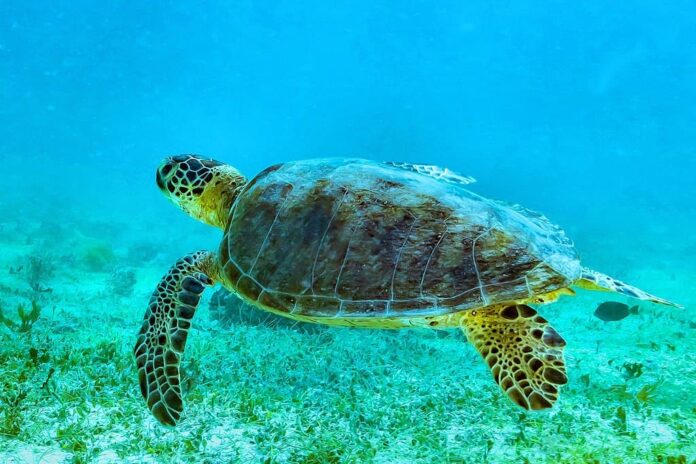
Green turtle, aka green sea turtle, aka black (sea) turtle, or Pacific green turtle is a large sea turtle species. Adult green turtles can grow up to 1.5 meters long, with an average weight of 68 to 190 kilograms. This marine turtle species has a very short snort and unhooked beak, and it cannot pull its neck into the shell. The carapace of the turtle is from 78 to 112 centimeters with various color patterns that change over time. Adults have black or brown carapaces with marbled or spotted rays while juveniles have dark brown to olive carapaces.
The range of these turtles is throughout the subtropical and tropical oceans around the world. There are 3 types of habitats that they live in during various life stages. They began from the beach, of course, and they spend most of their time in shallow coastal areas as they mature. As adults, green sea turtles frequent inshore bays, lagoons, and shoals with lush seagrass meadows instead. As juveniles, they are carnivorous so they eat crustaceans, fish, eggs, jellyfish, mollusks, and small invertebrates. They will become omnivores when they mature so they also feed on algae, leaves, seagrasses, tree barks, and more.
Only humans and large sharks, specifically tiger sharks feed on the green turtles of all sizes. While juveniles fall prey to literally anything such as crabs, shorebirds, small marine mammals, and more. This marine turtle species is susceptible to a variety of parasites such as barnacles, cestodes, leeches, nematodes, and protozoans. Barnacles attach to their carapaces while leeches attach to their flippers and skins which lead to blood loss. The rest of the parasites cause infections to their intestinal tract and liver which lead to the turtle’s death.
3Hawksbill
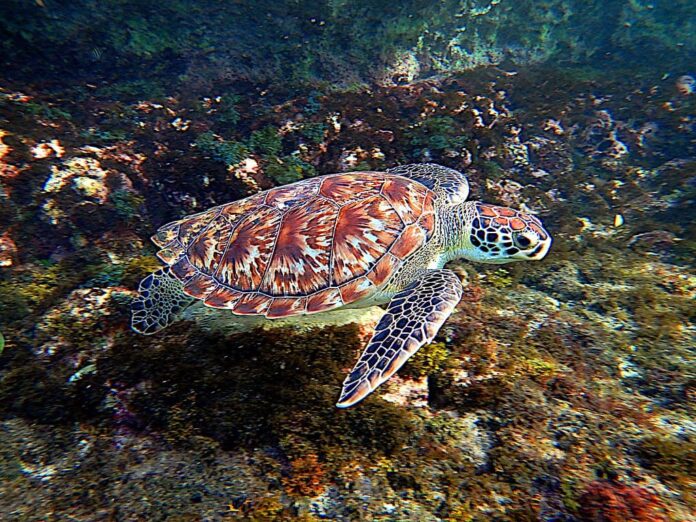
An adult hawksbill turtle can grow up to a meter long, weighing around 80 kilograms. When it comes to the appearance, this marine turtle species looks a lot different from the others. A hawksbill has an elongated and tapered head with a beak-like mouth and a sharply hooked beak that resembles a bird’s beak. Also, its forelimbs have two visible claws on each flipper. The unique thing about this marine turtle is the carapace which has an amber background with light and dark streak patterns. That is not all, this species is also biofluorescent which makes it the first reptile with this characteristic.
Hawksbill turtles are omnivores, and sea sponges take from 70% to 95% of their diet. This is great because they help maintain the health of coral reefs by removing sponges from the reef’s surface. This also allows better access for reef fish to feed which is a total plus. Apart from that, they also feed on algae, crustaceans, fish, jellyfish, marine plants, mollusks, sea anemones, and sea urchins. Just so you know, this sea turtle consumes venomous cnidarians like hydrozoan and Portuguese man o’ war. So it is possible that their flesh can be toxic.
Hawksbill sea turtles have a wide range, mostly in tropical coral reefs of the Atlantic, Indian, and Pacific Oceans. They are usually seen resting in caves and ledges in and around the reeds during the day. Since they are migratory, they also inhabit a wide range of habitats from lagoons and open oceans to mangrove swamps.
The hawksbill sea turtle is a critically endangered marine turtle species despite the global distribution. Habitat loss, nesting area loss, and pollution affect their population greatly while human and animal encroachment threatens their nesting sites.
4Kemp’s Ridley
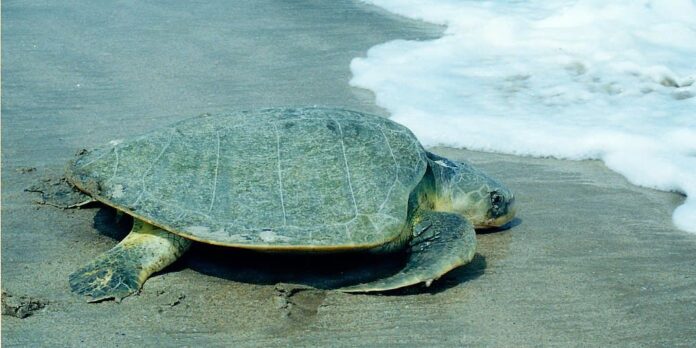
Kemp’s ridley sea turtle or Atlantic ridley sea turtle is the rarest marine turtle species in the world. Along with that, it is also the smallest sea turtle species, growing up to about 75 centimeters long. This turtle has a triangular-shaped head and a hooked beak with large crushing surfaces. Kemp’s ridley is the only sea turtle with an almost circular carapace that is usually olive-gray in color. On the carapace are 5 pairs of coastal scutes while there are 2 pairs of prefrontal scales on the head.
This sea turtle feeds on algae, crustaceans, fish, jellyfish, mollusks, sargassum, sea urchins, and seaweeds. More than that, they also prefer shallow waters where they dive to the bottom to feed on crabs and other shellfish. Kemp’s ridley sea turtle is the only marine turtle species that nest during the day. Each year, females return to Rancho Nuevo beach from April to August in Tamaulipas, Mexico to lay eggs. They arrive in large groups of hundreds or thousands in nesting aggregations while males stay closer to the breeding grounds.
The major threats to their population nowadays are egg harvesting and poaching as well as habitat loss and pollution. Entanglement in shrimping nets and bycatch also play a part in harming their numbers. Now, Kemp’s ridley sea turtles are classified as Endangered under the Endangered Species Act (SEA).
5Leatherback
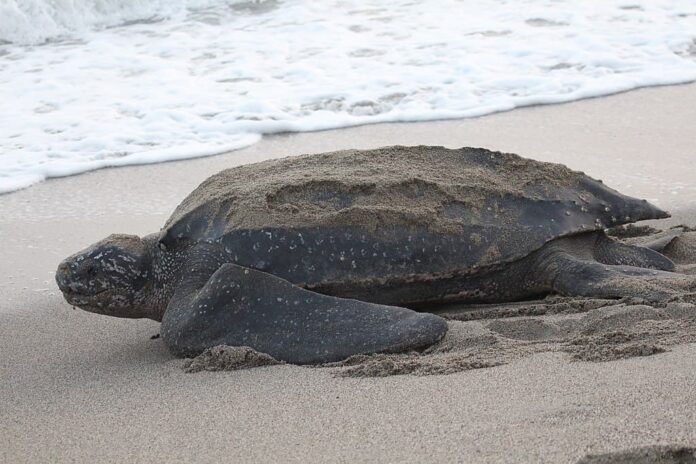
Leatherback sea turtle aka lute is the world’s largest living marine turtle species as well as the heaviest non-crocodilian reptile. It can reach the length of up to 1.8 meters long, weighing up to 500 kilograms. Besides the large size, its shell is also different as it is bony with a teardrop shape. The carapace of this turtle is covered by oily flesh and flexible leather-like skin; hence the name. This carapace also allows them to withstand high hydrostatic pressures as they dive to depths of 1200 meters. What many people find a nightmare is the inside of their mouth. Instead of teeth, leatherback sea turtles have backward spines in their throats that look absolutely horrendous.
Being a species with a cosmopolitan global range, leatherback sea turtles have the widest distribution across the world. They are found in all subtropical and tropical oceans in the Atlantic, Eastern Pacific, and Western Pacific Oceans. Where they live, they feed almost entirely on jellyfish which helps control jellyfish populations. They also feed on other soft-bodied organisms such as cephalopods, cnidarians, and tunicates as well as crustaceans, fish, sea urchins, and snails.
As hatchlings, their predators are birds, crustaceans, shorebirds, and small mammals that prey on them as they scramble for the sea. They have very few natural predators once they mature, and the main predator is humans. People hunt them for their fat and oil as well as raid their nests to collect their eggs. Some other threats are bycatch, climate change, nesting habitat degradation and loss, pollution, and vessel strikes.
6Loggerhead
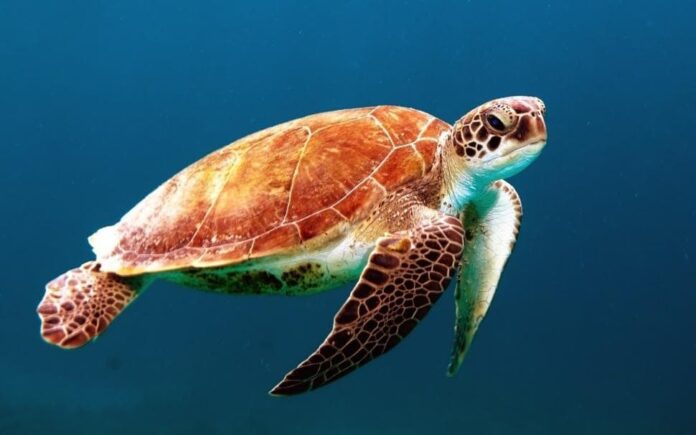
Loggerhead sea turtles have a distribution throughout the world, especially in the Atlantic, Indian, and Pacific Oceans, and the Mediterranean Sea. An average loggerhead is around 90 centimeters in the carapace, weighing up to 135 kilograms, making it the world’s largest hard-shelled turtle species. The skin of the turtle is yellow to brown with a reddish brown shell. One of the most impressive characteristics that they have is the large and powerful jaws that they use to crush prey.
The loggerhead sea turtles spend most of their lives in the open ocean and shallow coastal waters. There is a wide variety of food that they feed on including barnacles, crab larvae, fish eggs, hydrozoan colonies, sponges, etc. Hatchlings live in floating mats of Sargassum algae that provide them with both food and protection. So they can prey on ants, aphids, beetles, flies, and leafhoppers that are carried by the wind to the mats.
Not different from other marine turtle species, they have many predators early in their lives. The egg and nestling predators are ants, bears, beetles, crabs, flies, gulls, mustelids, opossums, skunks, snakes, and more. Birds and other mammals feed on the hatchlings while aquatic animals like moray eels and parrotfishes attack loggerhead juveniles. Only killer whales, larger sharks, and seals may prey on adult loggerhead turtles.
Apart from humans that collect their eggs, they also face many other threats around them. Those are bycatch, climate change, nesting site loss, pollution, and shrimp trawling that cause their population to decline. Loggerhead sea turtles have been listed as Threatened under ESA since 1978.
7Olive Ridley
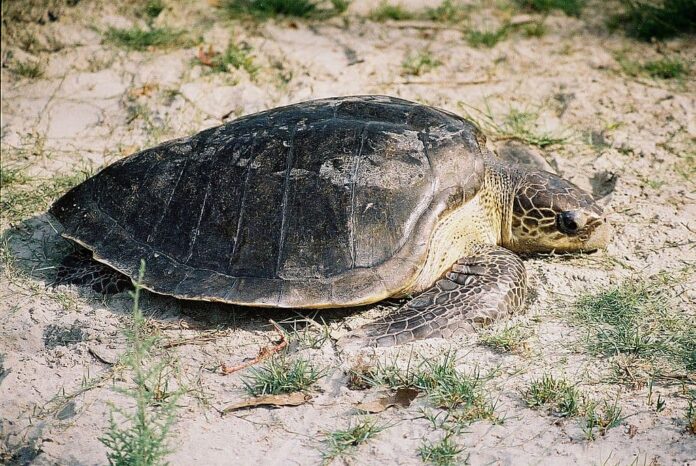
Quite small, an olive ridley grows up to only about 61 centimeters in carapace length. This marine turtle species got its name from its olive carapace which is in a heart and rounded shape. Olive ridley turtles live in tropical and warm waters of the Atlantic, Indian, and Pacific Oceans. Normally, they live in shallow marine waters but are occasionally found in open waters. In their habitats, these carnivores feed on bivalves, bryozoans, crabs, jellyfish, rock lobsters, salps, shrimps, snails, tunicates, and more.
The predators that prey on their eggs are caimans, coyotes, opossums, raccoons, sunbeam snakes, and more. Killer whales and sharks are the main predators for the adults, and the nesting females may be attacked by jaguars. Through their shells? Yes, jaguars are the only cats with a strong enough bite to penetrate a sea turtle’s shell. Besides those, other threats include coastal development, ghost nests, gill nets, longline fishing, natural disasters, pot fishing, and trawling.
Relates Post: Most Dangerous Turtles In The World

